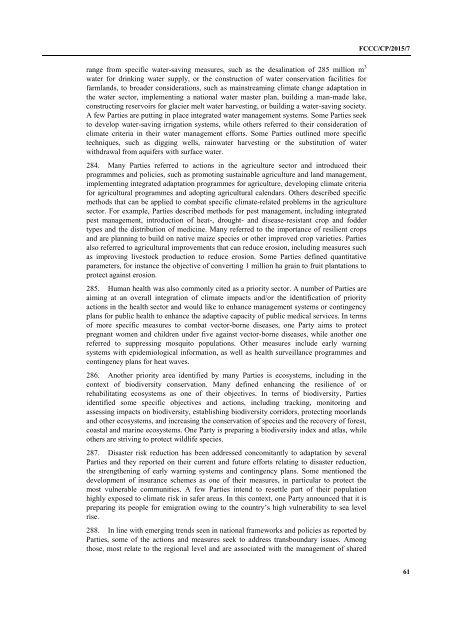FCCC/CP/2015/7
1PYuHQM
1PYuHQM
Create successful ePaper yourself
Turn your PDF publications into a flip-book with our unique Google optimized e-Paper software.
<strong>FCCC</strong>/<strong>CP</strong>/<strong>2015</strong>/7<br />
range from specific water-saving measures, such as the desalination of 285 million m 3<br />
water for drinking water supply, or the construction of water conservation facilities for<br />
farmlands, to broader considerations, such as mainstreaming climate change adaptation in<br />
the water sector, implementing a national water master plan, building a man-made lake,<br />
constructing reservoirs for glacier melt water harvesting, or building a water-saving society.<br />
A few Parties are putting in place integrated water management systems. Some Parties seek<br />
to develop water-saving irrigation systems, while others referred to their consideration of<br />
climate criteria in their water management efforts. Some Parties outlined more specific<br />
techniques, such as digging wells, rainwater harvesting or the substitution of water<br />
withdrawal from aquifers with surface water.<br />
284. Many Parties referred to actions in the agriculture sector and introduced their<br />
programmes and policies, such as promoting sustainable agriculture and land management,<br />
implementing integrated adaptation programmes for agriculture, developing climate criteria<br />
for agricultural programmes and adopting agricultural calendars. Others described specific<br />
methods that can be applied to combat specific climate-related problems in the agriculture<br />
sector. For example, Parties described methods for pest management, including integrated<br />
pest management, introduction of heat-, drought- and disease-resistant crop and fodder<br />
types and the distribution of medicine. Many referred to the importance of resilient crops<br />
and are planning to build on native maize species or other improved crop varieties. Parties<br />
also referred to agricultural improvements that can reduce erosion, including measures such<br />
as improving livestock production to reduce erosion. Some Parties defined quantitative<br />
parameters, for instance the objective of converting 1 million ha grain to fruit plantations to<br />
protect against erosion.<br />
285. Human health was also commonly cited as a priority sector. A number of Parties are<br />
aiming at an overall integration of climate impacts and/or the identification of priority<br />
actions in the health sector and would like to enhance management systems or contingency<br />
plans for public health to enhance the adaptive capacity of public medical services. In terms<br />
of more specific measures to combat vector-borne diseases, one Party aims to protect<br />
pregnant women and children under five against vector-borne diseases, while another one<br />
referred to suppressing mosquito populations. Other measures include early warning<br />
systems with epidemiological information, as well as health surveillance programmes and<br />
contingency plans for heat waves.<br />
286. Another priority area identified by many Parties is ecosystems, including in the<br />
context of biodiversity conservation. Many defined enhancing the resilience of or<br />
rehabilitating ecosystems as one of their objectives. In terms of biodiversity, Parties<br />
identified some specific objectives and actions, including tracking, monitoring and<br />
assessing impacts on biodiversity, establishing biodiversity corridors, protecting moorlands<br />
and other ecosystems, and increasing the conservation of species and the recovery of forest,<br />
coastal and marine ecosystems. One Party is preparing a biodiversity index and atlas, while<br />
others are striving to protect wildlife species.<br />
287. Disaster risk reduction has been addressed concomitantly to adaptation by several<br />
Parties and they reported on their current and future efforts relating to disaster reduction,<br />
the strengthening of early warning systems and contingency plans. Some mentioned the<br />
development of insurance schemes as one of their measures, in particular to protect the<br />
most vulnerable communities. A few Parties intend to resettle part of their population<br />
highly exposed to climate risk in safer areas. In this context, one Party announced that it is<br />
preparing its people for emigration owing to the country’s high vulnerability to sea level<br />
rise.<br />
288. In line with emerging trends seen in national frameworks and policies as reported by<br />
Parties, some of the actions and measures seek to address transboundary issues. Among<br />
those, most relate to the regional level and are associated with the management of shared<br />
61


